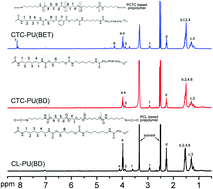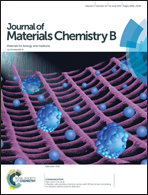Biocompatible, degradable thermoplastic polyurethane based on polycaprolactone-block-polytetrahydrofuran-block-polycaprolactone copolymers for soft tissue engineering†
Abstract
Biodegradable synthetic polymers have been widely used as tissue engineering scaffold materials. Even though they have shown excellent biocompatibility, they have failed to resemble the low stiffness and high elasticity of soft tissues because of the presence of massive rigid ester bonds. Herein, we synthesized a new thermoplastic polyurethane elastomer (CTC-PU(BET)) using a polyester ether triblock copolymer (polycaprolactone-block-polytetrahydrofuran-block-polycaprolactone triblock copolymer, PCTC) as the soft segment, an aliphatic diisocyanate (hexamethylene diisocyanate, HDI) as the hard segment, and a degradable diol (bis(2-hydroxyethyl)terephthalate, BET) as the chain extender. PCTC inhibited the crystallization and reduced the melting temperature of CTC-PU(BET), and BET dramatically enhanced the thermal decomposition and the hydrolytic degradation rate when compared with conventional polyester-based biodegradable TPUs. The CTC-PU(BET) synthesized in this study possessed a low tensile modulus and tensile strength of 2.2 MPa and 1.3 MPa, respectively, and an elongation-at-break of over 700%. Meanwhile, it maintained a recovery rate of 95.3% and a resilience of 90% over ten cycles of loading and unloading. In addition, TPU could be electrospun into both random and aligned fibrous scaffolds consisting of major microfibers and nanobranches. The 3T3 fibroblast cell culture confirmed that these scaffolds outperformed the conventional biodegradable TPU scaffolds in terms of substrate cellular interactions and cell proliferation. Considering the advantages of these TPU scaffolds, such as the ease of synthesis, low cost, low stiffness, high elasticity, controllable degradation rate, ease of processability, and excellent biocompatibility, they have great prospects for use as tissue engineering scaffold materials for soft tissue regeneration.



 Please wait while we load your content...
Please wait while we load your content...